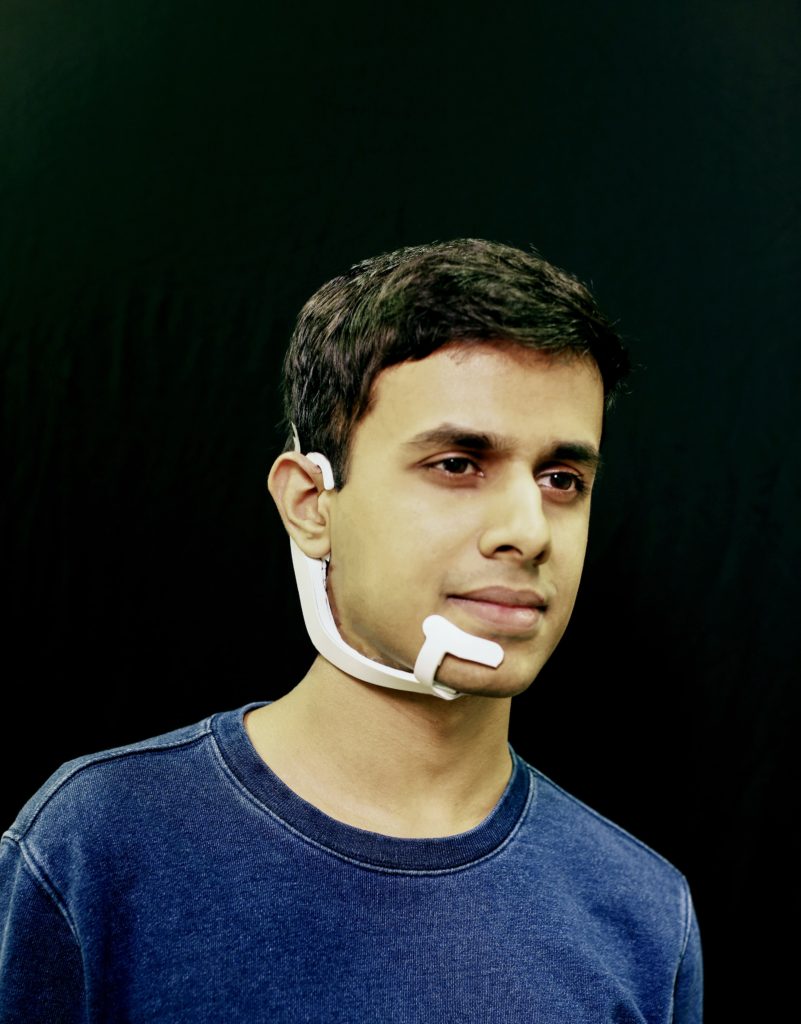Delhi-born Arnav Kapur, a graduate student from Massachusetts Institute of Technology (MIT), created a device that enables people to access the internet or any computing device without typing or using their voice or making physical gestures. AlterEgo is an associated computing system that can transcribe the words that a user says in their heads.
The young intelligence augmentation researcher from MIT Media Lab first introduced his prototype of AlterEgo in 2018. Arnav won the $15,000 Lemelson-MIT Student Prize for AlterEgo and was named a 2019 ‘TED Fellow.’ He then conducted a live public demo of his innovation for the first time at the TED conference. It was also named as Time’s 100 Best Inventions of 2020.
How It Works
Imagine this, you try talking to yourself without opening your mouth, by simply saying words internally. What if you could search the internet like that and get an answer back? In his live public demo, ‘TED Fellow’ Arnav Kapur introduced AlterEgo as a wearable AI device that is capable of letting you talk silently to and get information from a computer system, just like a voice inside your head. It’s a device that can give words to your internal speech.
How it works is, the machine picks up the neuromuscular signals in the jaw and face that are triggered by the internal verbalizations when a person says something in his head. These signals are undetectable to the human eye, but the machine-learning system that has been trained to correlate particular signals with particular words, will transcribe it. The implications of this unique human-computer interaction are far-reaching.
Also Read: Many Universities Now Offer Bachelors and Masters In Content Creation
The AlterEgo Beneficiaries
As per MIT, the project is primarily meant for individuals with speech disorders, including, among other conditions, ALS (amyotrophic lateral sclerosis) and MS (multiple sclerosis). Beyond that, the institute says, it has the potential to seamlessly integrate computing into people’s daily lives as their ‘second self’ and augment their cognition and abilities, hence the name AlterEgo.
The Device Structure
AlterEgo includes a pair of bone-conduction headphones, which transmit vibrations through the bones of the face to the inner ear. Since they do not obstruct the ear canal, the headphones enable the system to convey information to the user without interrupting the conversation or otherwise interfering with the user’s auditory experience.

Subvocalisation as a computer interface is largely unexplored. The researchers’ first step was to determine which locations on the face are the sources of the most reliable neuromuscular signals. Then, a prototype of a wearable silent-speech interface that touches the face at seven locations on either side of the mouth and along the jaws was developed.
The Mind Behind AlterEgo: Arnav Kapur
Arnav introduced himself a graduate student in the Fluid Interfaces group at the MIT Media Lab with a particular focus on Machine Intelligence, Cognition Augmentation and Human-Machine Collaboration. “My goal is to try to understand why things are the way they are and to thereby bring about positive mutations through engineering solutions” said the young researcher. He designed the AI-enabled headset along with his brother Shreyas and fellow researchers at the MIT Media Lab.

Take a look at some of Arnav’s major achievements:
- At Harvard Media School, he invented a platform to measure human gene expressions levels in an attempt to democratise gene profiling by bringing the costs down.
- AT MIT Media labs, Arnav co-developed a collaborative machine intelligence artist.
- He also co-designed and engineered the Lunar Rover (Indus) set to land on the moon in 2019. The rover will travel 500 meters on lunar soil and relay pictures back to Earth as part of the Google Lunar X Prize challenge.
- He invented and deployed a visual-aural assistive device Drishti.
- He engineered 3D printable quadcopter systems that could perform high acceleration movements without external sensor systems to facilitate their deployment in everyday living.
- At Fluid Interfaces group, he is working on human-machine integration in a complementary symbiosis.
A recently viral video shows Kapur wearing AlterEgo while being asked a series of questions by an interviewer. Arnav responds to each question almost instantly without uttering a word. The impressed interviewer exclaims, “You have the entire internet in your head!’
Arnav Kapur, a student in MIT’s Media Lab, has developed a system to surf the internet with his mind. He silently Googled our questions and heard the answers through vibrations transmitted through his skull and into his inner ear. pic.twitter.com/aN76Jn4AHv
— 60 Minutes (@60Minutes) April 22, 2018
Potential Threat
Any new piece of technology—and one as powerfully invisible as AlterEgo—tends to raise alarm bells. “Just to be very clear, the device doesn’t read or record your thoughts,” Kapur clarified in his TED talk. “It records deliberate information you want to communicate through the deliberate engagement of internal speech systems.” He believes that the technology can carry out the user’s intention by only reading signals from the voluntary part of the body.
Technology is becoming an even more integral part of our life with every passing day and advancements in the field are now taking place at an unfathomable pace. It makes us immensely proud that an Indian researcher studying at the prestigious MIT has achieved all the well-deserved appreciation for his hard-work!


